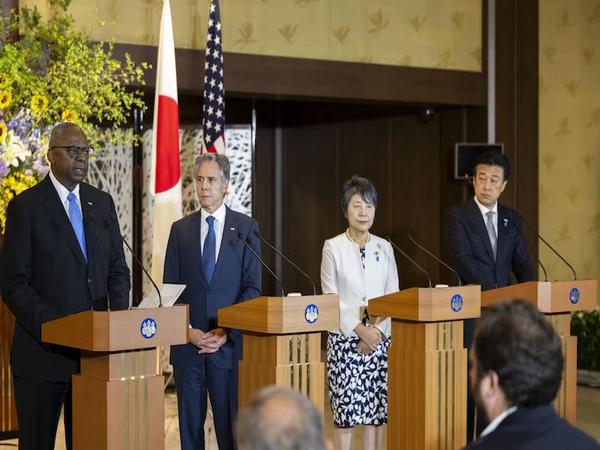United States and Japan on Sunday emphasized the importance of maintaining peace and stability across the Taiwan Strait and in the South China Sea amid China’s assertiveness in the region.
The two countries agreed Sunday to upgrade the command functions of the US forces in Japan for better coordination of the US-Japan bilateral alliance.
A US-Japan Security Consultative Committee meeting also referred to as the “2+2” in Tokyo today was attended by the US Defence Secretary Lloyd Austin and Japan Minister of Defence Kihara Minoru apart from US Secretary of State Anthony Blinken and the Japanese foreign minister Yoko Kamikawa.
Following the 2+2 Security talks, the foreign and defence ministers of the two countries vowed to explore ways to strengthen the US-Japan Alliance deterrence and response capabilities to uphold the free and open rules-based international order.
The US Defence Secretary and his counterparts underscored bilateral progress to build a global partnership for the future, including upgrading the command and control functions (C2) of the US forces in Japan, deepening defence industry and advanced technology cooperation, and enhancing cross-domain operations.
The extended deterrence includes US nuclear protection provided to Japan.
As per the joint statement of the US-Japan ministerial meeting on extended deterrence, the foreign and defence ministers of the two countries shared assessments of “an increasingly deteriorating regional security environment.”
The statement mentioned China’s accelerating and opaque expansion of its nuclear arsenal, and Russia’s undermining of arms control and the global nonproliferation regime, including through its expanding military cooperation and unlawful arms transfers with North Korea.
It also noted North Korea’s continued destabilizing behaviour and sustained pursuit of its unlawful nuclear and ballistic missile programs.
The United States and Japan reiterated the need to reinforce the Alliance’s deterrence posture, and manage existing and emerging strategic threats through deterrence, arms control, risk reduction, and non-proliferation.
The foreign and defence ministers of both the countries confirmed that US and Japan, through the Extended Deterrence Dialogue (EDD), will continue to explore how best to reinforce extended deterrence in order to promote regional stability and deter the outbreak of conflict.
Since 2010, US and Japanese officials have coordinated on extended deterrence policy primarily through the US-Japan EDD.
“We held a separate two-plus-two ministerial level meeting on extended deterrence, and that has never been done before,” US Defence Secretary Austin said addressing a joint press conference with Blinken and the two Japanese ministers after the high level meetings.
“During that meeting, I reaffirmed our ironclad commitment to defend Japan with the full range of our capabilities, including our nuclear capabilities,” Austin said.
The new joint force headquarters, Austin said, will be commanded by a three-star officer and will serve as a counterpart to Japan’s own Japan Self-Defence Forces Joint Operations Command.
Headquartered in Yokota Air Base in the suburbs of Tokyo, the joint force headquarters according to Austin will “facilitate deeper interoperability and cooperation on joint bilateral operations (with Japan) in peacetime and during contingencies.”
It will be commanded by a three-star officer who will report to the commander of US Indo-Pacific Command, the US Defence Secretary said.
According to a joint statement of the Security Consultative Committee Tokyo and Washington will explore co-production opportunities to expand production capacity of both the advanced medium-range air-to-air missiles and the Patriot advanced capability-3 ground-based interceptor missiles, both developed in the United States.
Japan and the United States reiterated the importance of maintaining peace and stability across the Taiwan Strait.
The ministers emphasized Taiwan’s political transition period “should not be used as a pretext for provocative actions across the Taiwan Strait.”
Immediately after Taiwanese President Lai Ching-te’s inauguration in May, China had conducted a military drill around the self-governed island.
Chinese military drill surrounding the island that took place after Taiwanese President Lai Ching-te’s inauguration in May.
US and Japanese ministers also expressed serious concerns about the dismantling of Hong Kong’s autonomy and freedoms as well as “China’s human rights issues, including in Xinjiang and Tibet.”
Meanwhile, US Secretary of State Antony Blinken met with Japanese Foreign Minister Kamikawa Yoko today in Tokyo and exchanged views on the bilateral alliance between the two countries and its role as the cornerstone of security and prosperity in the Indo-Pacific region.
US State Department spokesperson Matthew Miller stated that Blinken and Kamikawa committed to continuing progress on security commitments made during Japanese PM Fumio Kishida’s official visit to Washington, DC, in April this year as well as the Security 2+2 ministerial conference in Tokyo today.-ANI


